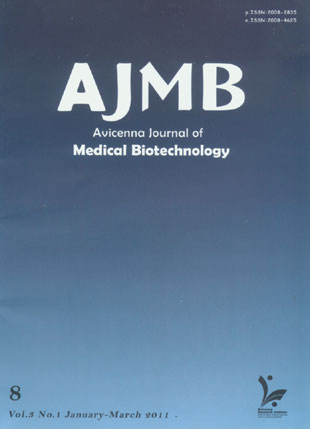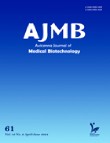فهرست مطالب

Avicenna Journal of Medical Biotechnology
Volume:3 Issue: 1, Jan-Mar 2011
- تاریخ انتشار: 1390/01/31
- تعداد عناوین: 8
-
-
Page 0
-
Page 3Lipopolysaccharide (LPS) is an important structural component of the outer cell membrane complex of gram-negative microorganisms. Its causative role in gram-negative bacteria-induced diseases and broad applications in different kinds of cell stimulation experiments provided a conceptual basis for studies directed at the isolation, purification, and detailed chemical characterization of LPS. The main problem with LPS purification protocols is the contamination of the end product with nucleic acids and proteins in variable proportions which could potentially interfere with downstream applications. In this study, a simple procedure for purification of LPS from Escherichia coli (E. coli) and Salmonella typhi (S. typhi) with high purity and very low contaminating nucleic acids and proteins based on the hot phenol-water extraction protocol has been introduced. The purity of extracted LPS was evaluated by silver and coomassie blue staining of SDS-PAGE gels and HPLC analysis. Limulus Amebocyte Lysate (LAL) coagulation activity and rabbit pyrogen assay were exploited to monitor the functionality of purified LPS. The results showed that DNase and RNase treatment of the sample is essential after the sonication step to eliminate nucleic acid contamination in the LPS fraction. Silver staining demonstrated ladder pattern which is characteristic of LPS. No contaminating protein was found as assessed by Coomassie blue staining. HPLC fractionation revealed high degree of purity comparable with commercial LPS. Parenteral administration of purified LPS resulted in substantial increase of rabbits’ body temperature (mean: 1.450C). LAL coagulation assay confirmed the functional activity of the purified LPS. In conclusion, the protocol presented here could be employed for isolation of LPS with high purity and functional activity.
-
Page 11Collagens are the most abundant proteins in the human body. Their main function is to provide structural and mechanical support for the tissues, but they are also involved in a number of other biological functions including cell attachment, migration and differentiation. Collagens and gelatins are widely used in pharmaceutical and medical applications. Every year, more than 50,000 tons of collagen and gelatin are used in medical applications. These materials may have some viral and prion impurity and/or stimulate allergic responses in human body. Therefore, scientists have produced human collagen in recombinant systems. In this study we have constructed two yeast shuttle vectors containing human procollagen genes expression cassette for expression in yeast. Total RNA was extracted from human skin fibroblast cell line, and cDNA synthesis was done by oligo dt. Then gene fragments were amplified from the cDNA with the necessary changes by Polymerase Chain Reaction (PCR). Finally they were cloned in yeast vector pPICZαA containing regulatory sequences for expressing and secreting the polypeptide product. Two yeast shuttle vectors containing human COL1A1 and COL1A2 expression cassettes were created. Final constructs were confirmed by enzymatic digestion, PCR of desired fragment and sequencing. The yeast shuttle vectors containing human COL1A1 and COL1A2 can be transferred into the yeast in the later stages to determine the scale of expression.
-
Page 19Bordetella pertussis is a gram negative bacterium that causes respiratory tract infection in human (whooping cough). Pertussis toxin (PT) is the main component of current acellular pertussis vaccine and the S1 (subunit1) is the main immunogenic part of it. Thus, S1 has been the target of many studies as a potent candidate of acellular vaccine against Bordetella pertussis, lacking the side effects of whole cell based ones. S1 gene was amplified and inserted in three expression vectors including pET-14, pET-22b(+) and pAED4. The possibility and level of expression of these constructs were investigated in BL21 (DE3) strain of Escherichia coli (E.coli) as expression host. The highest expression was in pET-22b(+)-S1. Best expression achieved 6 hr post induction with 0.2 mM IPTG in LB broth containing ampicillin, at 30°C with shaking (250 rpm). Recombinant S1 protein was observed in two distinct separated proteins with 28 and 31 kDa estimated molecular weight. In spite of toxicity of PT and S1 in the E.coli, considerable amount of S1 was expressed in E.coli. Two rS1 bands were detected on SDS-PAGE. Both were confirmed as S1 in western blot with specific monoclonal and polyclonal antibodies against pertussis toxin. Appearance of two distinct bands could be the result of leader peptidase activity or nonspecific peptidase from E.coli on recombinant S1. As the recombinant S1 is a suitable antigen for studies as a candidate acellular vaccine or development of ELISA for detection of Bordetella pertussis, further studies are underway.
-
Page 25Genomic Signal Processing is a relatively new field in bioinformatics, in which signal processing algorithms and methods are used to study functional structures in the DNA. An appropriate mapping of the DNA sequence into one or more numerical sequences enables the use of many digital signal processing tools in the analysis of different genomic sequences. Also, a novel Influenza A (H1N1) virus of swine origin emerged in the spring of 2009 and spread very rapidly among people. The severity of the disease and the number of deaths caused by a pandemic virus varies greatly and can change over time. Throughout this work, Pandemic H1N1 genomic sequences were characterized according to nonlinear dynamical features such as moment invariants and largest Lyapunov exponents and then compared to those features that extracted from classical H1N1 genomic sequences. The proposed methods were applied to a number of sequences encoded into a time series using a coding measure scheme employing Electron-Ion Interaction Pseudopotential (EIIP). The aim of this work is to extract genomic features that can distinguish the new swine flu from the classical H1N1 existed before using sequences from segment 8 of the influenza genome that consists of 8 RNA segments which encodes two important proteins for immune system attack (NS1 and NS2). According to the obtained results it is evident that variability is present based on a significance test in both groups; pandemic and classical H1N1 sequences.
-
Page 31The aim of the study was to study the anti-ulcer activity of the methanolic extract of the leaves of Capparis zeylanica Linn on experimental animal models. The methanol extract of Capparis zeylanica Linn. leaves was investigated for anti-ulcer activity against aspirin plus pylorus ligation induced gastric ulcer in rats. HCl-Ethanol induced ulcer in mice and Indomethacin induced ulcer in rats at 200 mg/kg body weight p.o. A significant (p<0.01, p<0.001) anti-ulcer activity was observed in all the models. Pylorus ligation showed significant (p<0.01) reduction in gastric volume, free acidity and ulcer index as compared to control. It also showed 88.5% ulcer inhibition in HCl-ethanol induced ulcer and 83.78% inhibition in Indomethacin induced ulcer.
-
Page 37The aqueous leaves extract of Sesbania sesban (L) Merr. (Family: Fabaceae) was evaluated for its antidiabetic potential on normal and streptozotocin (STZ)-induced diabetic rats. In the chronic model, the aqueous extract was administered to normal and STZ- induced diabetic rats at the doses of 250 and 500 mg/kg body weight (b.w.) p.o. per day for 30 days. The fasting Blood Glucose Levels (BGL), serum insulin level and biochemical data such as glycosylated hemoglobin, Total Cholesterol (TC), Triglycerides (TG), High Density Lipoproteins(HDL) and Low Density Lipoproteins (LDL) were evaluated and all were compared to that of the known anti-diabetic drug glibenclamide (0.25 mg/kg b.w.). The statistical data indicated significant increase in the body weight, liver glycogen, serum insulin and HDL levels and decrease in blood glucose, glycosylated hemoglobin, total cholesterol and serum triglycerides when compared with glibenclamide. Thus the aqueous leaves extract of Sesbania sesban had beneficial effects in reducing the elevated blood glucose level and lipid profile of STZ-induced diabetic rats.
-
Page 45Irritable Bowel Syndrome (IBS) is a functional gastrointestinal disorder, characterized by recurrent abdominal pain and altered bowel habits. This study was performed to investigate the important role of interleukin-12 (IL-12) in intestinal inflammation. For this study seventy one patients with IBS and 140 controls were investigated. The allele and genotype frequencies of IL-12 C(-1188)A were determined using polymerase chain reaction with sequence-specific primers. The allele A was more common that the allele C in both groups of patients and controls. There was not any significant difference on IL-12 alleles and genotypes between patients and controls. The AA genotype was the most common genotypes, which was seen in 57.4% of the patients and 51.4% of the controls (p=0.53). Although frequency of the CC genotype in the control group was lower than the patient group, this difference was not significant (5.7% vs. 11.5%, respectively, p=0.16). Considering the lack of association between IL-12 C(-1188)A polymorphism and IBS, this cytokine gene polymorphism may not have significant role in the pathophysiology of disease.


